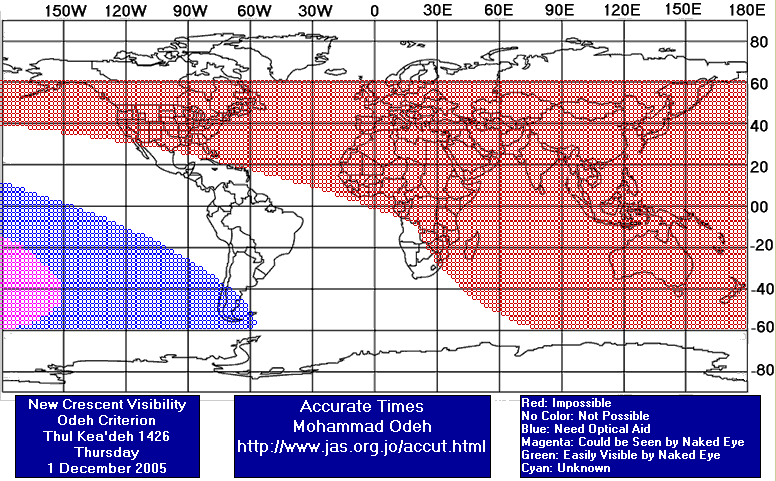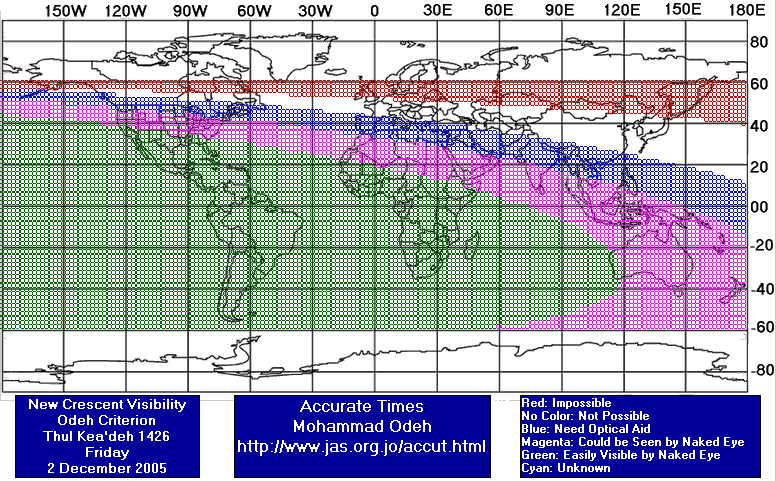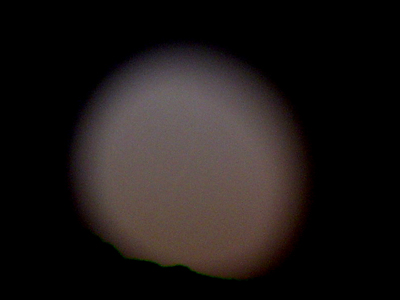Visibility of Thul Keadah Crescent
(1426 AH)
- When to Observe Thul Keadah Waxing (NEW) Crescent ?
- Thul Keadah Waxing (NEW) Crescent Observation Results
- The OFFICIAL First Day in Different Countries
- When to Observe Shawwal Waning (OLD) Crescent ?
- Shawwal Waning (OLD) Crescent Observation Results
In Other Pages:-
- ICOP Main Page
- Members of ICOP (Individuals)
- Members of ICOP (Groups)
- Friends of ICOP
- ICOP Membership Application (For Individuals)
- ICOP Membership Application (For Groups)
- ICOP Observation Report Form
- ICOP Related Links
The geocentric conjunction (Geocentric New Moon) will occur Inshalla on (Thursday 01 December 2005), at
15:01 UT. On this day it is impossible to see the crescent from most parts of the world, while on the next day (Friday 02 December 2005) the program Accurate Times by Mohammad Odeh -according to Odeh criterion- showed that it is possible to see the crescent by optical aid from part of Asia, Europe Africa North America, where as it should be seen by naked eye from western southern parts of Asia, South Africa and South America.
According to the actual sighting of the crescent, the start of Thul Keadah should be on Saturday 03 December 2005 in most parts of the world.
- Results of seeing the crescent, and the first day of the month in different countries will be added here Inshalla as we receive the reports from ICOP's members. If you wish to be a member in ICOP, or to know more about it, kindly click here.
So far, the earliest sighting of the crescent was on Friday 02 December 2005 from Australia.
Thursday 01 December 2005:
Friday 02 December 2005:
The report of Thul Kea'dah new moon crescent observation :
It was done with binoculars 15x70 and was continued for a little minutes.
Friday 02 December 2005 :
Saturday 03 December 2005 :
The geocentric conjunction (Geocentric New Moon) will occur Inshalla on (Thursday 01 December 2005), at
15:01 UT. On this day the program Accurate Times by Mohammad Odeh -according to Odeh criterion- showed that the OLD crescent should be visible by optical aid from southern Africa, while it should be seen by naked eye with difficulty from Australia and South Eastern parts of Asia.

When to Observe Thul Keadah Waxing (NEW) Crescent ?



Thul Keadah Waxing (NEW) Crescent Observation Results
"Date: December 2, 2005
Reporter: Alireza Mehrani
Photographer: Alireza Mehrani
Location: 200 km west of Esfahan, Iran
Lat: 33° 15.23' N
Lon: 50° 09.96' E
Ele: 2610 m
TZ: = +3.5
Sunset (at sea level): 17:01:44
Sunset (observed): 16:58
Crescent first observation through 15x80 binoculars by Alireza Mehrani:
Time: 17:05:40 LT
Moon Alt: 2.982°
Elongation: 12.819°
Crescent final observation through 25x100 & 15x70 binoculars by Ali Ebrahimi
and Abbas Ahmadiyan:
Time: 17:23:25
Moon Alt: 0.104°
Elongation: 12.934°
Observers: Alireza Mehrani (15x80 bin), Ali Ebrahimi (25x100 bin), Abbas
Ahmadiyan (15x70 bin), Saeed Janghorban (15x70 bin), Mahdi Mansuri (20x60 bin),
Mohammad Soltanolkottabi (15x70 bin)."

From: The Astronomy and Geophysics Centre Of Shahreza
(This Centre is located in Iran , Isfahan , Shahreza )
Reporter : Hossein Janghorbani
We could see this attractive and crusial new moon crescent on Dec . 2 .2005 , On Friday night at 17:10 LT in local damzad mountains with these location parameters :
Lat : 32° 0' N
Lon : 51° 52' E
Ele : 2325 m
Tz : = +3.5
Sunset (at sea level) : 16:51
Sunset (observed) : 16:58
Crescent first observation through
15x70 binoculars by Hossein Janghorbani :
Time : 17:10 LT
Moon Alt : 2.151
Elongation : 12.817
At the moment of observation q= -0.321
And same other groups in Isfahan saw this crescent too.
"The Dhul Qada [1426 AH] Hilaal was clearly visible by naked-eye from Sea Point, Cape Town,
this Friday evening of the 2nd December 2005. In Southern Africa the official first day of Dhul
Qada will therefore correspond with Saturday, 3rd December 2005. I first observed the very thin
crescent [cusps at 4 to 8 o’clock] through 10 x 50 binoculars at 10 minutes after observed local
sunset. The crescent became visible to the naked-eye at 20h03 – 18 minutes after local sunset.
Venus had appeared at sunset.
Naked-eye observation – Dhul Qada Hilaal 1426 AH
Date : Friday, 02/12/2005
Observed local sunset : 19h45
Sighting locality – Sea Point – 0 meters above sea level
[band of cloud on the horizon to an altitude of 1°]
First sighted by naked-eye at 20h03
[topocentric q]
Moon altitude : +09°:43':02"
Elongation : +14°:35':46"
Azimuth: +03°:29':17"
Width : +00°:00':31"
Illumination : 01.62 %
Magnitude: -05.44
Distance: 370486.85 km
Moon-age : 25 hr 45 min"

The OFFICIAL First Day in Different Countries

When to Observe Shawwal Waning (OLD) Crescent ?






